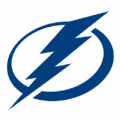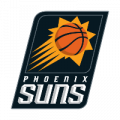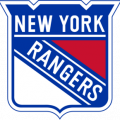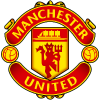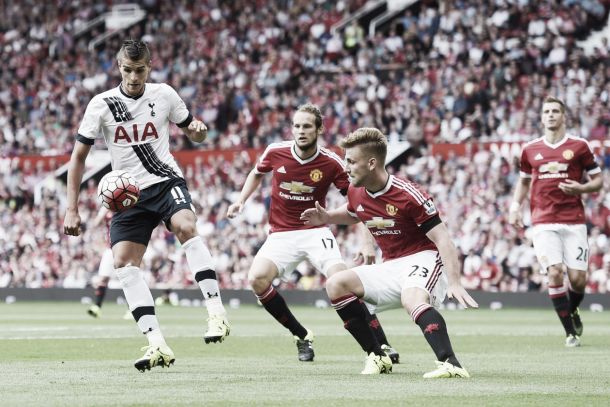Manchester United’s start to the season has been under some scrutiny despite losing just once in all competitions, with performances lacking, particuarly in the Premier League. Scoring twice in domestic competitions, much of the criticism has been directed towards the build-up play and the strikeforce.
Although their attack may be faltering, Louis van Gaal infamously acquired both Memphis Depay and Anthony Martial in the summer transfer window. Additions in defence have been less common though, signing just one right-back in the form of Matteo Darmian.
With Phil Jones sustaining an injury, Tyler Blackett being loaned to Celtic and Jonny Evans joining West Brom, the Dutch manager has been forced to place Daley Blind at centre-back since the opening day. His countryman ordinarily plys his trade in defensive midfield but is now playing between Chris Smalling and Luke Shaw amongst the back four.
With difficult fixtures against the likes of Liverpool and Arsenal following the international break, will this lack of depth be their downfall? Signs against Club Brugge and Swansea City suggests so, with Shaw and Blind proving this makeshift line-up may be punished against superior opposition.
How did they line up?
Van Gaal set his sides up, against Club Brugge and Swansea City, in a 4-2-3-1 formation that continues to be used frequently throughout the modern game. The back four remained unchanged as Matteo Darmian, Chris Smalling, Daley Blind and Luke Shaw all retained their places in the starting XI.
Ander Herrera and Michael Carrick protected these defenders in the Champions League, however, the latter was replaced as both Bastian Schweinsteiger and Morgan Schneiderlin resumed midfield responsibilities at the Liberty Stadium. This meant Herrera was played in the number 10 role in place of the injured Adnan Januzaj, who started in Brugge, while Juan Mata and Memphis Depay found themselves either side of Wayne Rooney up front.
Manchester United utilised the left flank in Belgium
The warning signs were there for Club Brugge, a team boasting a home record to be envious of in European competition, after just a matter of minutes. The first leg showed that a large proportion of United’s attacking threat is provided on the flanks, with both Depay and Mata causing havoc a week prior.
Two attacking full-backs made sure that, when on the wing, there were often three United players operating the flank that the ball was located on. By the end of the first-half, the average positioning of the players made it look as though United were trialling a 2-4-3-1 formation due to the attacking prowess of both Shaw and Darmian.
The opening goal, 20 minutes in, came down the aforementioned left-wing as newboy Memphis Depay cut inside once again before slotting the ball into a then goal-shy Wayne Rooney.
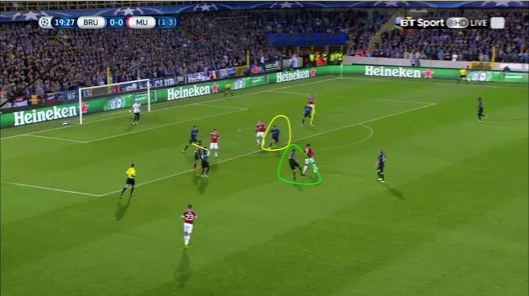
His pace got the better of the right-back and subsequently forced Claudemir, circled in green above, to try and win the ball. Proving too fast for the holding midfielder, and with defenders occupied by Adnan Januzaj and Juan Mata respectively, Oscar Duarte had no choice but to leave Rooney unmarked to close the onrushing Depay down. A clever reverse pass from the forward sent the Englishman away to delicately chip the ball over debutant Sinan Bolat in the Brugge goal.
In terms of the Manchester outfit’s defending, they very much put pressure on their inferior opponents that night. Luke Shaw emphasised this style, winning the ball and creating chances through pressing both Jean-Charles Castelletto and Diaby.
This pressure was paying off and the second goal of the game epitomised this tactic. After losing the ball from a short corner, the away side were quick to close down their opposition and win a throw-in near the corner flag. A free-kick given away by Darmian was taken quickly by Blauw-Zwart and, due to both Bastian Schweinsteiger and Luke Shaw closing the ball down, United were in front seconds later.
As the ball was being worked across the field, Schweinsteiger, on for Januzaj at half-time, forced Diaby into a poor pass that was quickly pounced upon by Shaw. The 20-year-old passed first time to Depay, who found Herrera before this well-worked move was finished off in style by Wayne Rooney.
Defensive issues
There proved to be a downside, showcased just before the interval as Diaby evaded Shaw to gift Tom De Sutter another opportunity. The England left-back was forced to close down Diaby in midfield on this occasion, leaving his position susceptible for Castelletto to exploit. Shaw firstly attempted to pass the responsibility of marking Diaby onto Herrera before Blind told him otherwise, leaving the latter covering whilst Michael Carrick slotted into the centre of defense.
As seen above, although Castelletto is blocked by the scoreboard, Blind’s quick decision to move towards the right-back gives Diaby an opportunity to send his team-mate through on goal. He did exactly that and, with Blind and Smalling trailing, forced Sergio Romero into a save.
In a pulsating end to the half for the Belgians, another opportunity was created on the left just moments later. Once again Shaw pressed Castelletto high up the pitch before the ball went long to De Sutter, who held it up well under pressure from Smalling. The centre-back stayed close to the now Bursaspor man but exposed an extensive amount of space behind him, which Diaby used to full effect as Shaw dealt with Castelletto and Blind decided to move towards the ball.
Further worries were on show in the defeat to Swansea City the following Sunday, with both of the Swans’ goals coming down that left hand side. Getting in behind Luke Shaw proved easy for both the in-form Bafetimbi Gomis and Andre Ayew throughout the game.
A strike from Gomis in the first-half showed the French international targetted Blind, revealing the considerable space between Shaw and the World Cup semi-finalist. This effort happened to strike the post but United did not learn from their mistakes, conceding the equaliser with both Shaw and Blind involved once more. Caught on the counter attack, Luke Shaw’s distance from Blind is large and forces the 25-year-old to fill the void. Occupied by Gylfi Sigurdson, Blind leaves Chris Smalling with the task of marking both Gomis and Ayew with Morgan Schneiderlin failing to track the latter’s run.
This is certainly a learning curve for Blind, even at 25. This experience will no doubt help his understanding of the game and give Louis van Gaal an idea of what Blind is capable of. Two astute signings in Schneiderlin and Schweinsteiger spells a lengthy stint on the bench for Blind, with Phil Jones’ return iminent.
A change in the system or even a left-back may suit Blind, with Shaw leaving his team-mate very susceptible to the counter attack, but these changes will be made to accommodate just one player. The relationship between the pair is understandably not up to scratch, which contrasts to the opposing flank.
In contrast, Mata and Darmian work well together
From one floundering area of the pitch to one very much flourishing. Much has been made of Juan Mata’s role as an inside forward in Van Gaal’s Manchester United side. Impressing greatly in previous Premier League seasons in a central position, the former Chelsea man has found success despite an unfamiliar role in the team.
Able to cut inside on his favoured left foot to find a killer pass, his instinct to move away from the touchline allows Matteo Darmian further space when making an overlap. Although this was visible when Mata set up Rooney for his hat-trick a fortnight ago, the right-back was not utilised but did not need to be.
In the build up it was clear that the reds were the team in front, as Bolingoli Mbombo and his team-mates charged forward when the Belgian Supercup holders had a chance of winning the ball. This allowed Herera the time to pick out Mata, who took the ball towards the centre of the penalty area before slotting the ball into Rooney. With everyone in European football aware of Mata’s ability in front of goal, the full-back inevitably focused on Mata and left Darmian unattended.
There was further evidence of this during the defeat to Swansea. Garry Monk set his side out in a midfield diamond, with Jonjo Shelvey monitoring Mata’s side of the pitch. As seen in the screen grab below, Shelvey has tracked Mata into the middle and left Darmian in acres of space on the right.
Can this partnership continue?
Phil Jones is expected to be available for selection in just a few weeks time following the discovery of minor thrombosis in his leg, forcing the defender to miss every game of the season thus far, and is likely to be returned to the fore once fully fit.
The restoration of an assured centre-back will no doubt improve the fortunes of Manchester United’s defense in the long term, with Blind certain to be displaced. The victory over Club Brugge demonstrated that there is potential for teams to take advantage of the Red Devils’ defense, before this was confounded against Swansea City just days later.
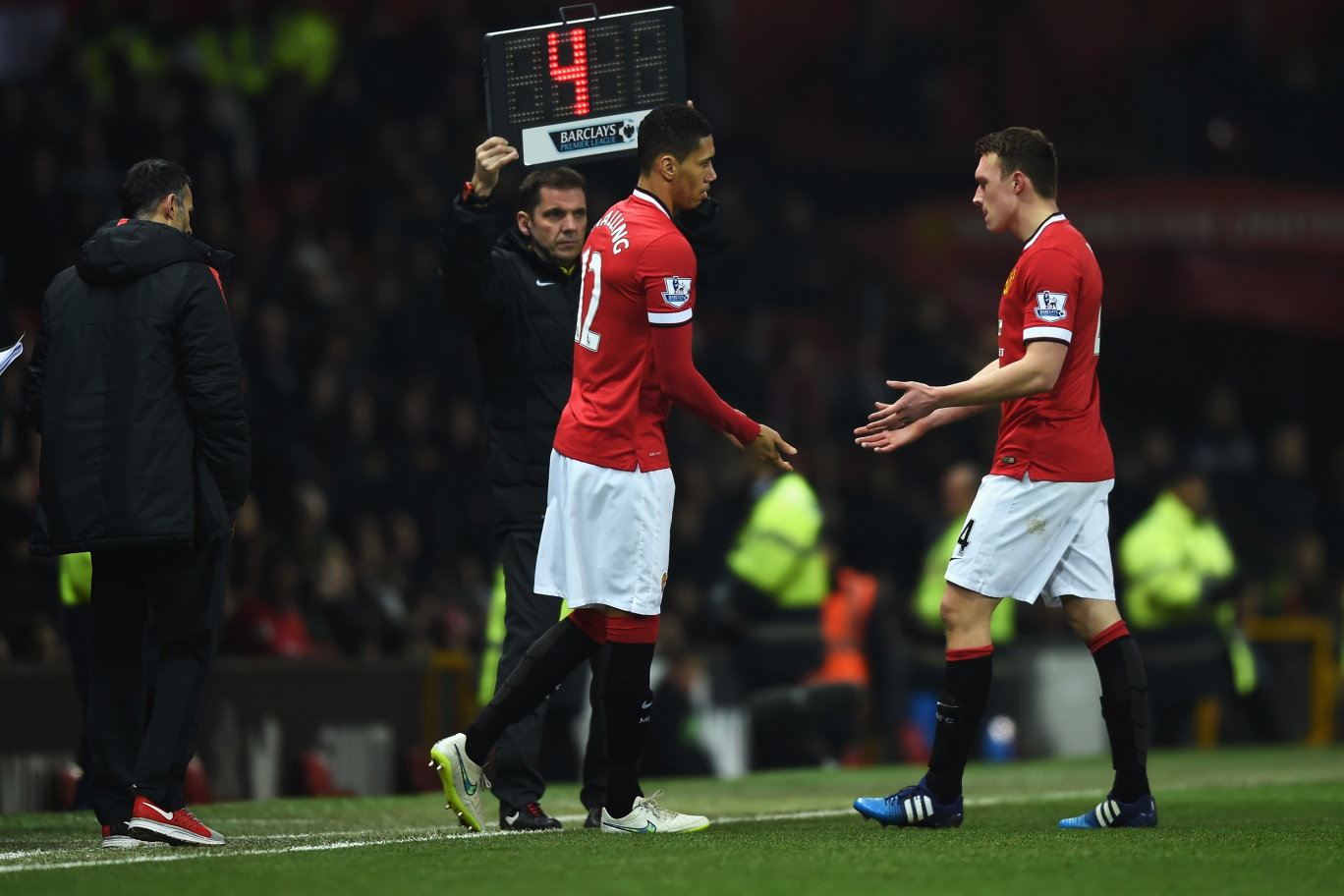
Phil Jones is likely to be reunited with Chris Smalling. (Getty Images)
A much better team in Swansea used this weakness to their advantage and, with the likes of Liverpool, Southampton, Arsenal, Everton and Manchester City coming in their next six league outings, Louis Van Gaal will need his defense to be at their best.
Daley Blind’s partnership with Luke Shaw was always destined to be temporary, holding the fort until Jones returned from his serious injury. Although the performances have not been disastrous since the start of the current campaign, signing another central defender in the summer transfer window might have been ideal.
The duo are likely to start when Liverpool travel to Manchester this Sunday and, with the likes of Roberto Firmino and Christian Benteke up front, it could be a long evening for United’s back line.



































